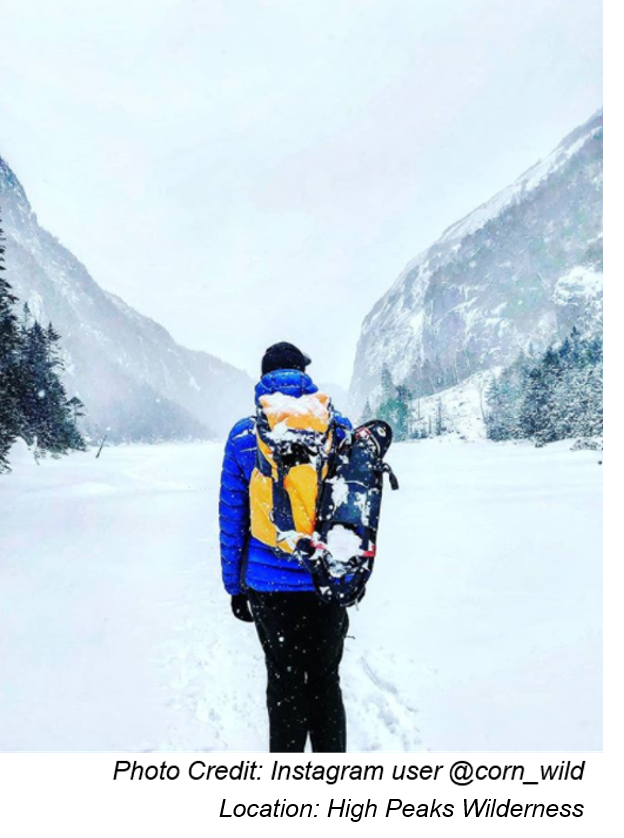|
Have a safe and enjoyable outdoor recreational experience on the lands and waters of the Adirondacks. Properly plan and prepare for your outdoor adventure. Minimize the impact on the mountains and forests, rivers and brooks, ponds and lakes, and the wildlife of the Adirondacks.
Backcountry Information for the Adirondacks web pages provide information on access, outdoor recreation infrastructure, and current conditions for those planning to recreate in the Adirondacks.
Would you like your photo shared in our weekly bulletin? Send us your photos that represent current backcountry conditions in the Adirondacks. Send in your photos with your name and photo location/brief description to Info.R5@dec.ny.gov or simply tag #NYSDEC on Instagram.
PLAN
Weather forecasts and conditions can and do change quickly. Check the current National Weather Service Forecast and be prepared for the forecasted conditions or change your plans.
-
Park in designated parking areas at trail heads—do not block gates, entrances, exits and other vehicles. When parking your vehicle, be considerate and do not take up more spaces than necessary. Trailheads and parking areas are expected to be full during the holiday weekend.
- Be courteous of others. Plan for busier trails this holiday weekend. Be courteous of others while
 recreating regardless of their activity, speed, or skill level. Hike in single file, especially when approaching other hikers. Stay to the right and pass on the left when safe and appropriate. Allow faster hikers to pass. When approaching other hikers from behind, politely let them know of your presence and desire to pass. recreating regardless of their activity, speed, or skill level. Hike in single file, especially when approaching other hikers. Stay to the right and pass on the left when safe and appropriate. Allow faster hikers to pass. When approaching other hikers from behind, politely let them know of your presence and desire to pass.
- Carry crampons. Most trails are now covered in snow, however warmer temperatures this week will bring icier conditions back to lower elevations. Trails on bedrock summits and other exposed areas in the higher elevations still have thick, hard ice where crampons are necessary. Carry mountaineering or climbing crampons if you plan to encounter these conditions and use when warranted.
- Bring snowshoes or skis for use in deep snow to reduce injuries and ease travel. Their use also prevents “post-holing”—leaving deep footprints in the snow – which makes trails more difficult and hazardous for others to use. Snowshoes or skis are required in the High Peaks Wilderness and recommended wherever snow depths exceed 8”.
PREPARE
Properly prepare to better ensure a safe and enjoyable winter recreation experience.
-
Unexpected weather is likely at high elevations. Be prepared to encounter unexpected weather such as high winds on exposed trails and summits. Bring extra layers and be prepared to turn around if the weather becomes too dangerous.
- Sun protection. The holiday weekend is forecasted to be partly sunny. Don’t be misled by temperatures, always wear sunscreen or UV protected clothing when out recreating. Even in the cold, the sun still emits dangerous UV rays.
- Sunglasses are important for eye protection even in the winter. The intensity of sunlight is increased significantly when reflects off bright white snow. Polarized lenses with UV protection are best when recreating on a sunny winter day.
PRACTICE LEAVE NO TRACE
 Follow proper trail etiquette to maintain minimal impact on the environment and the natural resources of the Adirondacks as well as ensuring an enjoyable outdoor experience for all visitors by following the Seven Principles of Leave No Trace Follow proper trail etiquette to maintain minimal impact on the environment and the natural resources of the Adirondacks as well as ensuring an enjoyable outdoor experience for all visitors by following the Seven Principles of Leave No Trace
- Plan Ahead and Prepare (Principle #1)
- Prepare for unexpected overnight stays. There are many dangerous variables when recreating in the winter. If you find yourself injured or lost, rescuers may have a more difficult and longer time reaching you, and you have to spend the night. Being prepared is essential. Always carry a headlamp, space blanket and/or sleeping bag, tent or other form of shelter, hand and feet warmers, emergency whistle, first aid kit, pocket knife, fire making tools, extra snacks and water, dry layers and socks. It may seem like a lot of extra weight to your pack but you will be safer and happier if the unexpected occurs
- Dispose of Waste Properly (Principle #3)
- Pack it in, pack it out. Pack out everything you brought in with you. Trash and litter should not be buried in the snow. Be sure and pick up all food scraps and other litter. Bring along an extra trash bag to pack out litter left behind by others. Solid human waste should be packed out. If packing human waste out is not an option, it should be disguised in deep snow well away from travel routes and at least 200 feet from water sources. Snow makes a great natural alternative to toilet paper. If you do use toilet paper, be sure to use it sparingly and pack it out
- Be Considerate of Other Visitors (Principle #7)
- Respect other visitors and protect the quality of their experience. Avoid loud voices and noises. Keep pets on a leash and under control. Yield to others on the trail.
GENERAL CONDITIONS/NOTICES
Learn the conditions you will encounter from Adirondack Backcountry Information.
- Holiday Weekend: Expect to encounter more vehicles at trailheads and more people and snowmobiles on trails. See highlighted trail below for a family friendly holiday adventure at Camp Santanoni Winter Weekend event.
-
Winter Conditions (below freezing temperatures, snow, and ice) are present throughout the Adirondacks. Snow depths range from 8 to 20 inches with deeper snows in some localities and in the higher elevations. See the NERFC Snow Page for current snow information. Learn how to have a safe and enjoyable outdoor winter experience.
-
Snow on Trails: Trails are covered in 8 to 20 inches of snow. Trails may have ice on the surface of the snow due to recent and forecasted warm weather and rain. Snow shoes or skis are recommended and should be worn on all trails. Trail crampons and other traction devices should be carried for use on lower elevation, less steep trails.
- Ice on Trails: Thick ice is present on bedrock summits, steep rocky slopes, and other exposed areas. Thick ice is also present under snow, especially in windblown sections of trail. Carry mountaineering or climbing crampons if you plan to encounter these conditions and use when warranted – trail crampons are ineffective.
-
Mountain Summit Conditions will be more extreme than those found at the trailhead. Temperatures will be colder, winds will be stronger, wind chill temperatures will be much lower, and snow will be deeper. Check the National Weather Service Mountain Point Forecasts for selected summits.
- Ice on Water Surface: Ice has formed and thickened on most water bodies. Ice on rivers and streams is less thick. Be safe on ice.
- Always check the thickness of ice before traveling across it.
- Avoid ice:
- Over running water
- Near inlets & outlet
- Near boathouses & docks - especially those with "bubblers" or other ice prevention devices
SPECIFIC NOTICES
Notices below reflect recent changes in conditions and recreation infrastructure work completed by DEC and its partners.
- High Peaks Wilderness:
- Lake Colden Caretaker reports 34 inches (90 cm) of snow at the stake on the shores of Lake Colden (Elevation 2,750 ft./838 m) with up to 5 to 6 feet snow (120 to 180 cm) in the higher elevations.
- Snowshoes or skis are required wherever snow depths exceed 8 inches, essentially all trails.
- There is good snow coverage on all trails, but trails are icy on the surface due to recent and forecasted warm weather and rain.
- Lake Colden and Avalanche Lake are crossable but ice around the inlets and outlets of both lakes should be avoided.
- The Cascade Lakes Day Use area, located off State Route 73 between Lower and Upper Cascade Lakes, is closed until further notice due to the icy condition of the unmaintained entry road.
HIGHLIGHTED TRAIL- Camp Santanoni XC Trail, Newcomb, NY
Camp Santanoni provides a 9.8-mile round trip cross-country ski excursion. The trail traverses from the Gate Lodge Complex, past the Farm Complex, to the remote lakeside Main Camp Complex, providing a moderate ski and a great opportunity to enjoy the outdoors. For those who don't have their own skis or snowshoes, the Adirondack Interpretive Center provide snowshoes free of charge to visitors at the Gate Lodge.
Trailhead: Camp Santanoni Historic Area is accessed from the Gate Lodge Parking Area, located on Newcomb Lake Road, off NY Route 28N. (43.9737°N, 74.1650°W)
Skiers and snowshoers are welcome to recreate on the trail and surrounding lands on any day during the winter. However, during the Winter Weekend events which includes this coming  weekend, February 17th-19th, cross-country skiers and snowshoers will be able to visit both the Gate Lodge and Main Lodge of Camp Santanoni, view displays about the great camp and take interpretive tours with Adirondack Architectural Heritage (AARCH) staff. weekend, February 17th-19th, cross-country skiers and snowshoers will be able to visit both the Gate Lodge and Main Lodge of Camp Santanoni, view displays about the great camp and take interpretive tours with Adirondack Architectural Heritage (AARCH) staff.
The Artist's Studio, a stone building near the main lodge on the shores of Newcomb Lake, is open as a warming hut during Winter Weekend events. Visitors can warm themselves by the woodstove and enjoy coffee, tea or hot chocolate - you are encourage to bring your own cup.
In addition to the popular 9.8-mile round trip from the Gate Lodge to the Main Lodge, cross-country skiers and snowshoers are encouraged to take the half mile-trail that connects Camp Santanoni to the nearby Adirondack Interpretive Center's 3.6-mile trail system. The Center's buildings are open from 10 a.m. to 4 p.m. on the Winter Weekends.
Reservations are not required but for more information, contact AARCH at (518) 834-9328
More information on Camp Santanoni Historic Area
|


 recreating regardless of their activity, speed, or skill level. Hike in single file, especially when approaching other hikers. Stay to the right and pass on the left when safe and appropriate. Allow faster hikers to pass. When approaching other hikers from behind, politely let them know of your presence and desire to pass.
recreating regardless of their activity, speed, or skill level. Hike in single file, especially when approaching other hikers. Stay to the right and pass on the left when safe and appropriate. Allow faster hikers to pass. When approaching other hikers from behind, politely let them know of your presence and desire to pass.  Follow proper trail etiquette to maintain minimal impact on the environment and the natural resources of the Adirondacks as well as ensuring an enjoyable outdoor experience for all visitors by following the
Follow proper trail etiquette to maintain minimal impact on the environment and the natural resources of the Adirondacks as well as ensuring an enjoyable outdoor experience for all visitors by following the  weekend, February 17th-19th, cross-country skiers and snowshoers will be able to visit both the Gate Lodge and Main Lodge of Camp Santanoni, view displays about the great camp and take interpretive tours with Adirondack Architectural Heritage (AARCH) staff.
weekend, February 17th-19th, cross-country skiers and snowshoers will be able to visit both the Gate Lodge and Main Lodge of Camp Santanoni, view displays about the great camp and take interpretive tours with Adirondack Architectural Heritage (AARCH) staff.